Low-Dimensional Multi-Trace Impedance Inversion in Sparse Space with Elastic Half Norm Constraint
Abstract
1. Introduction
2. Methodology
2.1. MII Method
2.2. LMII Framework
2.3. Constrained LMII Model via EH Norm
3. Examples
3.1. Synthetic Example
3.2. Field Example
4. Discussion
5. Conclusions
Author Contributions
Funding
Data Availability Statement
Acknowledgments
Conflicts of Interest
References
- Harrison, C.B. Feasibility of Rock Characterization for Mineral Exploration Using Seismic Data. Ph.D. Thesis, Curtin University, Perth, Australia, 2009. [Google Scholar]
- Kieu, D.T.; Kepic, A. Seismic-impedance inversion with fuzzy clustering constraints: An example from the Carlin Gold district, Nevada, USA. Geophys. Prospect. 2020, 68, 103–128. [Google Scholar] [CrossRef]
- Donoso, G.A.; Bautista, C.; Malehmir, A.; Araujo, V. Characterizing volcanogenic massive sulphides using acoustic impedance inversion, Neves-Corvo, southern Portugal. In NSG2022 4th Conference on Geophysics for Mineral Exploration and Mining; European Association of Geoscientists and Engineers: Belgrade, Serbia, 2022; pp. 1–5. [Google Scholar]
- Russell, B.; Hampson, D. Comparison of poststack seismic inversion methods. In SEG Technical Program Expanded Abstracts 1991; Society of Exploration Geophysicists: Houston, TX, USA, 1991; pp. 876–878. [Google Scholar]
- Dai, R.; Yin, C.; Zaman, N.; Zhang, F. Seismic inversion with adaptive edge-preserving smoothing preconditioning on impedance model. Geophysics 2019, 84, R25–R33. [Google Scholar] [CrossRef]
- Tikhonov, A. On the solution of ill-posed problems and the method of regularization. Dokl. Akad. Nauk. SSSR 1963, 151, 501–504. [Google Scholar]
- VanDecar, J.C.; Snieder, R. Obtaining smooth solutions to large, linear, inverse problems. Geophysics 1994, 59, 818–829. [Google Scholar] [CrossRef]
- Sacchi, M.D. Reweighting strategies in seismic deconvolution. Geophys. J. Int. 1997, 129, 651–656. [Google Scholar] [CrossRef]
- Gholami, A.; Siahkoohi, H.R. Regularization of linear and nonlinear geophysical ill-posed problems with joint sparsity constraints. Geophys. J. Int. 2010, 180, 871–882. [Google Scholar] [CrossRef]
- Aghamiry, H.S.; Gholami, A.; Operto, S. Compound regularization of full waveform inversion for imaging piecewise media. IEEE Trans. Geosci. Romote Sens. 2020, 58, 1192–1204. [Google Scholar] [CrossRef]
- Zhang, F.; Dai, R.; Liu, H. Seismic inversion based on L1-norm misfit function and total variation regularization. J. Appl. Geophys 2014, 109, 111–118. [Google Scholar] [CrossRef]
- Gholami, A. Nonlinear multichannel impedance inversion by total-variation regularization. Geophysics 2015, 80, R217–R224. [Google Scholar] [CrossRef]
- Li, C.H.; Zhang, F.C. Amplitude-versus-angle inversion based on the L1-norm-based likelihood function and the total variation regularization constraint. Geophysics 2017, 82, R173–R182. [Google Scholar] [CrossRef]
- Guo, S.; Wang, H. Seismic absolute acoustic impedance inversion with L1 norm reflectivity constraint and combined first- and second-order total variation regularizations. J. Geophys. Eng. 2019, 16, 773–788. [Google Scholar] [CrossRef]
- Dai, R.; Yang, J. An alternative method based on region fusion to solve L0-norm constrained sparse seismic inversion. Explor. Geophys. 2021, 52, 624–632. [Google Scholar] [CrossRef]
- Zhang, R.; Castagna, J. Seismic sparse-layer reflectivity inversion using basis pursuit decomposition. Geophysics 2011, 76, R147–R158. [Google Scholar] [CrossRef]
- Zhang, R.; Sen, M.K.; Srinivasan, S. A prestack basis pursuit seismic inversion. Geophysics 2013, 78, R1–R11. [Google Scholar] [CrossRef]
- Wang, L.; Zhou, H.; Liu, W.; Yu, B.; He, H.; Chen, H.; Wang, N. Data-driven multichannel poststack seismic impedance inversion via patch-ordering regularization. Geophysics 2021, 86, R197–R210. [Google Scholar] [CrossRef]
- Wang, G.; Chen, S. Pre-stack seismic inversion with L1-2-norm regularization via a proximal dc algorithm and adaptive strategy. Surv. Geophys. 2022, 43, 1817–1843. [Google Scholar] [CrossRef]
- Ma, M.; Zhang, R.; Yuan, S.Y. Multichannel impedance inversion for nonstationary seismic data based on the modified alternating direction method of multipliers. Geophysics 2019, 84, A1–A6. [Google Scholar] [CrossRef]
- Zhang, F.C.; Liu, J.; Yin, X.Y.; Yang, P.J. Modified Cauchy-constrained seismic blind deconvolution. Oil Geophys. Prospect. 2008, 43, 391–396. [Google Scholar]
- Dai, R.; Zhang, F.; Liu, H. Seismic inversion based on proximal objective function optimization algorithm. Geophysics 2016, 81, R237–R246. [Google Scholar] [CrossRef]
- Sun, J.; Li, Y. Adaptive Lp inversion for simultaneous recovery of both blocky and smooth features in a geophysical model. Geophys. J. Int. 2014, 197, 882–899. [Google Scholar] [CrossRef]
- Hamid, H.; Pidlisecky, A. Multitrace impedance inversion with lateral constraints. Geophysics 2015, 80, M101–M111. [Google Scholar] [CrossRef]
- Yuan, S.Y.; Wang, S.X.; Luo, C.M.; He, Y.X. Simultaneous multitrace impedance inversion with transform-domain sparsity promotion. Geophysics 2015, 80, R71–R80. [Google Scholar] [CrossRef]
- Hamid, H.; Pidlisecky, A. Structurally constrained impedance inversion. Interpretation 2016, 4, T577–T589. [Google Scholar] [CrossRef]
- Dai, R.; Zhang, F.; Yin, C.; Hu, Y. Multi trace post stack seismic data sparse inversion with nuclear norm constraint. Acta Geophys. 2021, 69, 53–64. [Google Scholar] [CrossRef]
- Yang, Y.; Xia, X.; Yin, X.; Li, K.; Wang, J.; Liu, H. Data-driven fast prestack structurally constrained inversion. Geophysics 2022, 87, N31–N43. [Google Scholar] [CrossRef]
- Karimi, P. Structure constrained relative acoustic impedance using stratigraphic coordinates. Geophysics 2015, 80, A63–A67. [Google Scholar] [CrossRef]
- Yin, X.Y.; Yang, Y.M.; Li, K.; Man, J.; Li, H.; Feng, Y. Multitrace inversion driven by cross-correlation of seismic data. Chin. J. Geophys. 2020, 63, 3827–3837. [Google Scholar]
- Zhang, Y.; Wu, W.; Zhang, M.; Liang, M.; Feng, B. Multitrace Impedance Inversion Based on Structure-Oriented Regularization. IEEE Geosci. Remote Sens. Lett. 2021, 19, 1–5. [Google Scholar] [CrossRef]
- Donoho, D.L. Compressed sensing. IEEE Trans. Inf. Theory 2006, 52, 1289–1306. [Google Scholar] [CrossRef]
- Baraniuk, R.G. Compressive sensing. IEEE Signal Process. Mag. 2007, 24, 118–121. [Google Scholar] [CrossRef]
- Lan, N.Y.; Zhang, F.C.; Li, C.H. Robust high-dimensional seismic data interpolation based on elastic half norm regularization and tensor dictionary learning. Geophysics 2021, 86, V431–V444. [Google Scholar] [CrossRef]
- Lions, P.L.; Mercier, B. Splitting algorithms for the sum of two nonlinear operators. SIAM J. Numer. Anal. 1979, 16, 964–979. [Google Scholar] [CrossRef]
- Lan, N.Y.; Zhang, F.C. Seismic data recovery using deep targeted denoising priors in an alternating optimization framework. Geophysics 2022, 87, V279–V291. [Google Scholar] [CrossRef]
- Berteussen, K.; Ursin, B. Approximate computation of the acoustic impedance from seismic data. Geophysics 1983, 48, 1351–1358. [Google Scholar] [CrossRef]
- Barrett, R.; Berry, M.; Chan, T.F.; Demmel, J.; Donato, J.M.; Dongarra, J.; Eijkhout, V.; Pozo, R.; Romine, C.; Van der Vorst, H. Templates for the Solution of Linear Systems: Building Blocks for Iterative Methods; Society for Industrial and Applied Mathematics: Philadelphia, PA, USA, 1994; pp. 64–68. [Google Scholar]
- Candes, E.; Romberg, J.; Tao, T. Robust uncertainty principles: Exact signal reconstruction from highly incomplete frequency information. IEEE Trans. Inf. Theory 2006, 52, 489–509. [Google Scholar] [CrossRef]
- Huang, H.; Misra, S.; Tang, W.; Barani, H.; Al-Azzawi, H. Applications of compressed sensing in communications networks. arXiv 2014, arXiv:1305.3002. [Google Scholar]
- Xu, Z.B.; Chang, X.Y.; Xu, F.; Zhang, H. L1/2 regularization: A thresholding representation theory and a fast solver. IEEE Trans. Neural Netw. Learn. Syst. 2012, 23, 1013–1027. [Google Scholar]
- Sorensen, H.V.; Jones, D.L.; Burrus, C.S.; Heideman, M.T. On computing the discrete Hartley transform. IEEE Trans. Acoust. Speech Signal Process. 1985, 33, 1231–1238. [Google Scholar] [CrossRef]

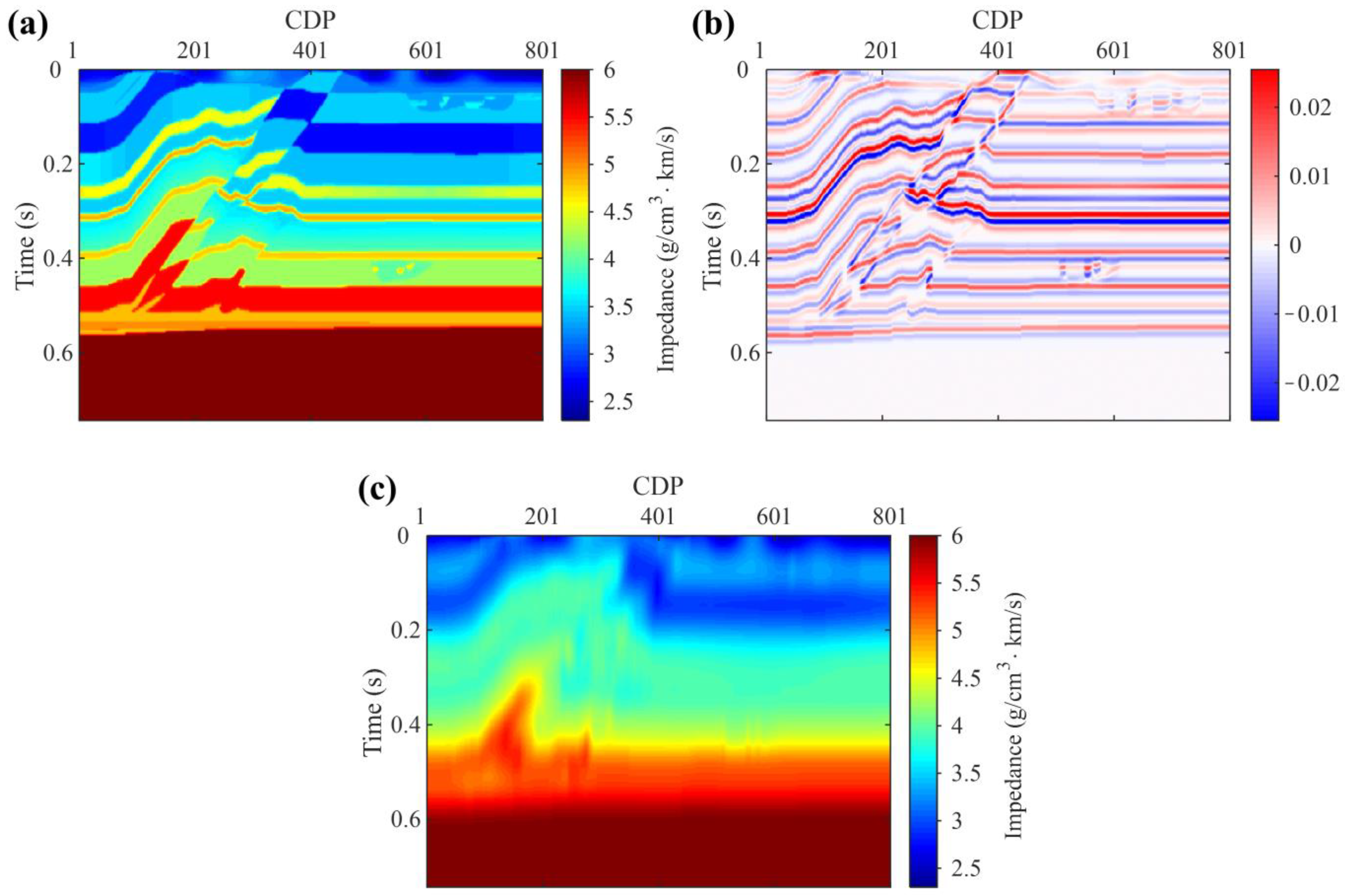
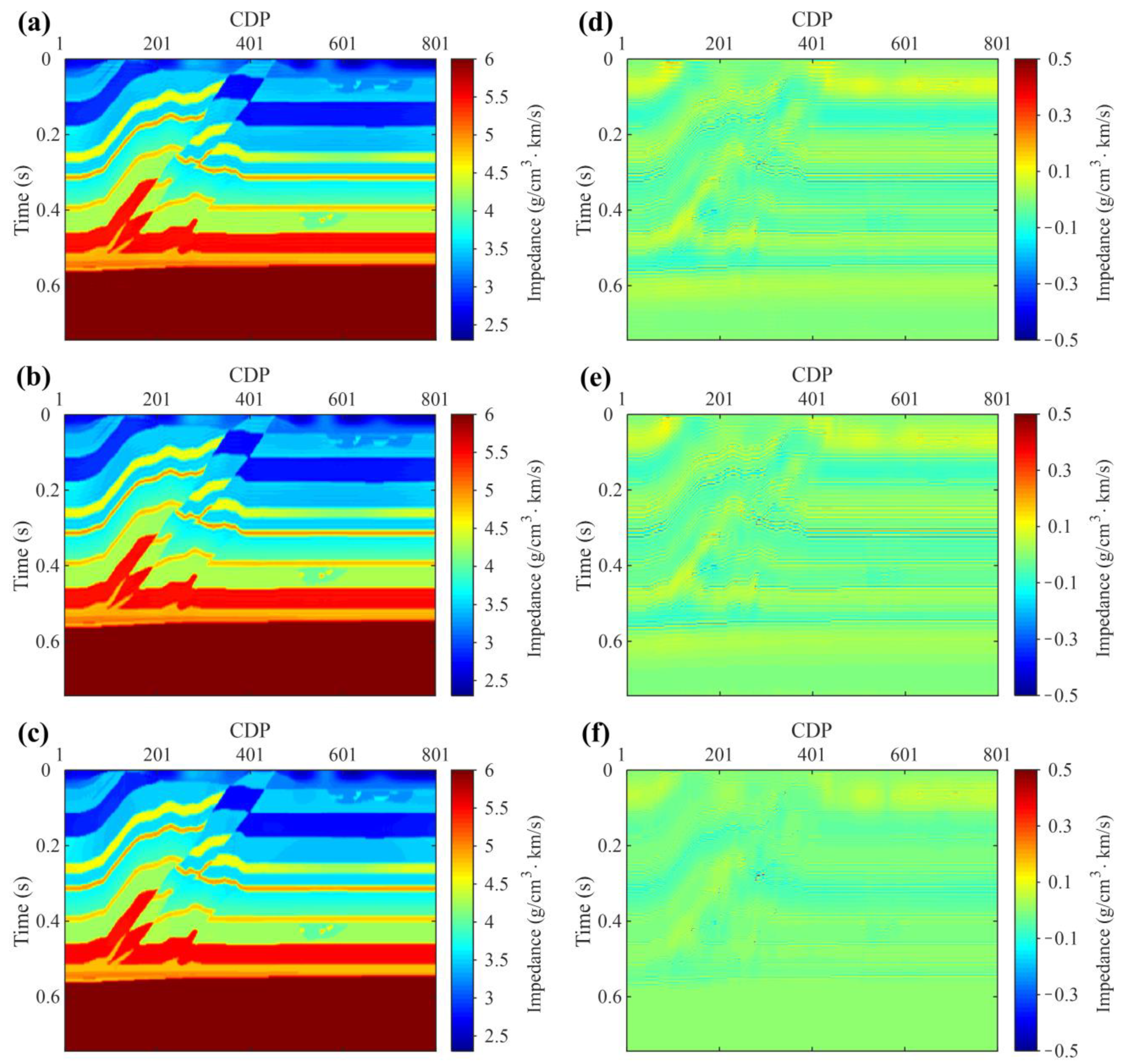

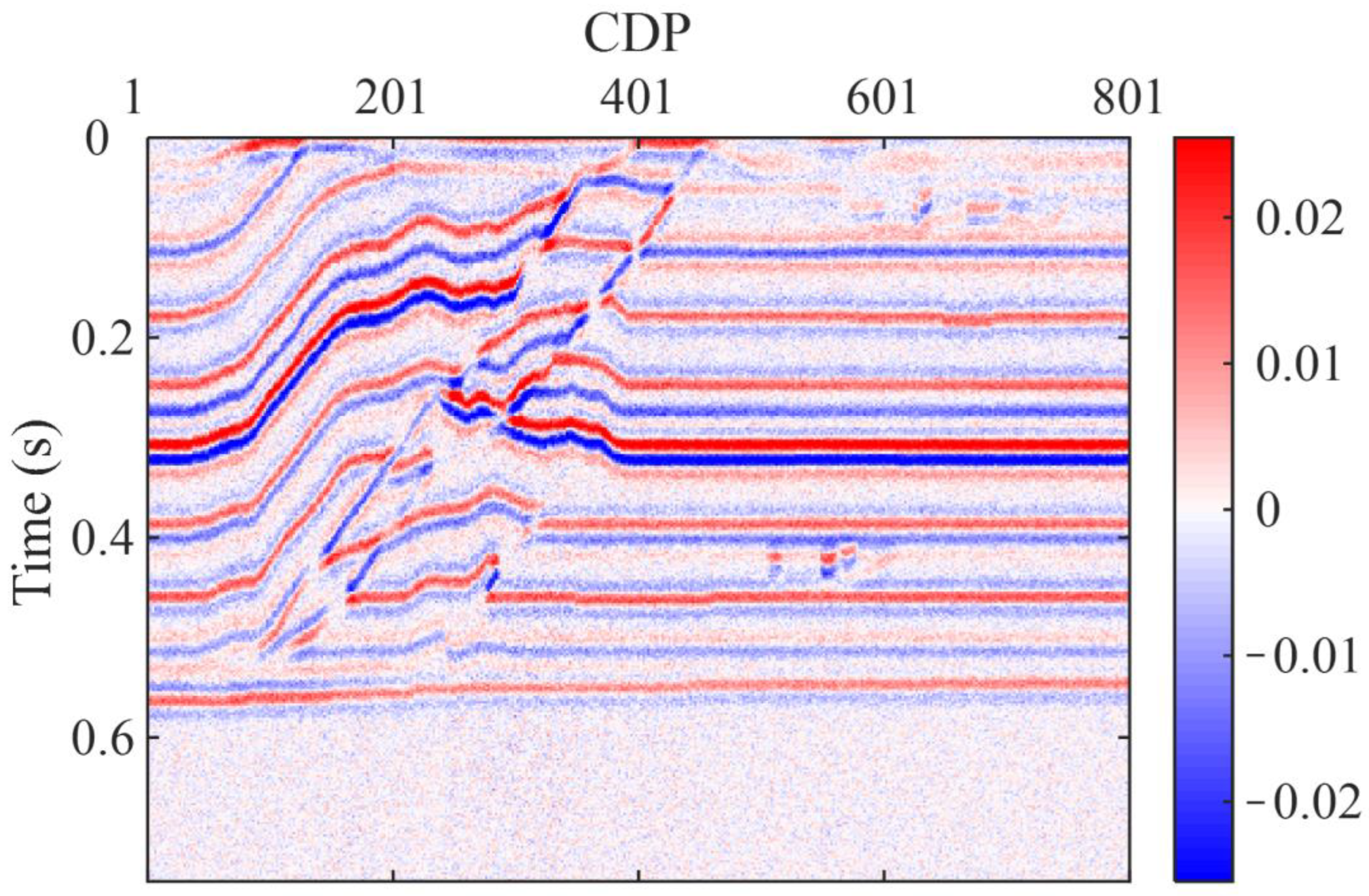
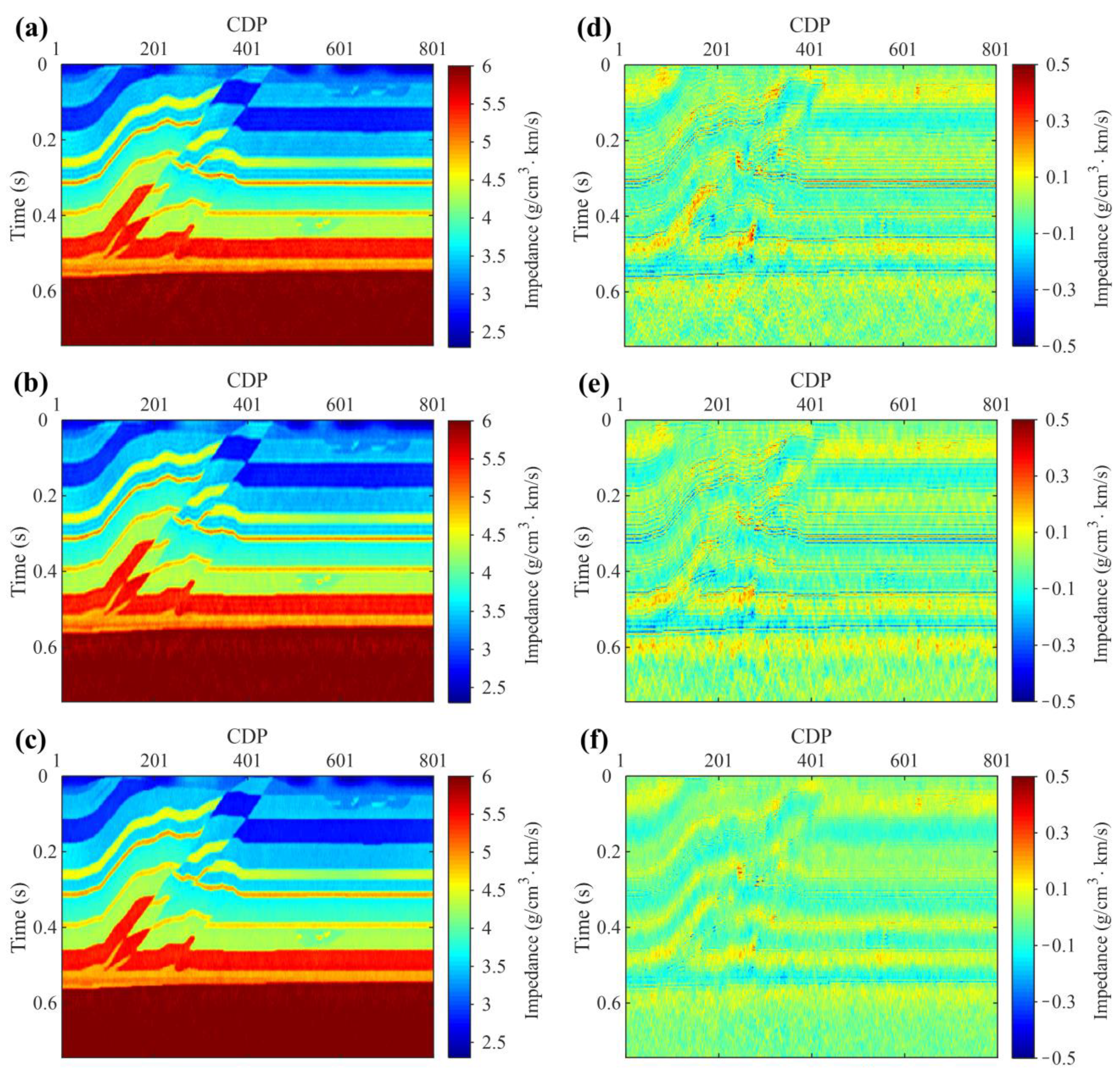
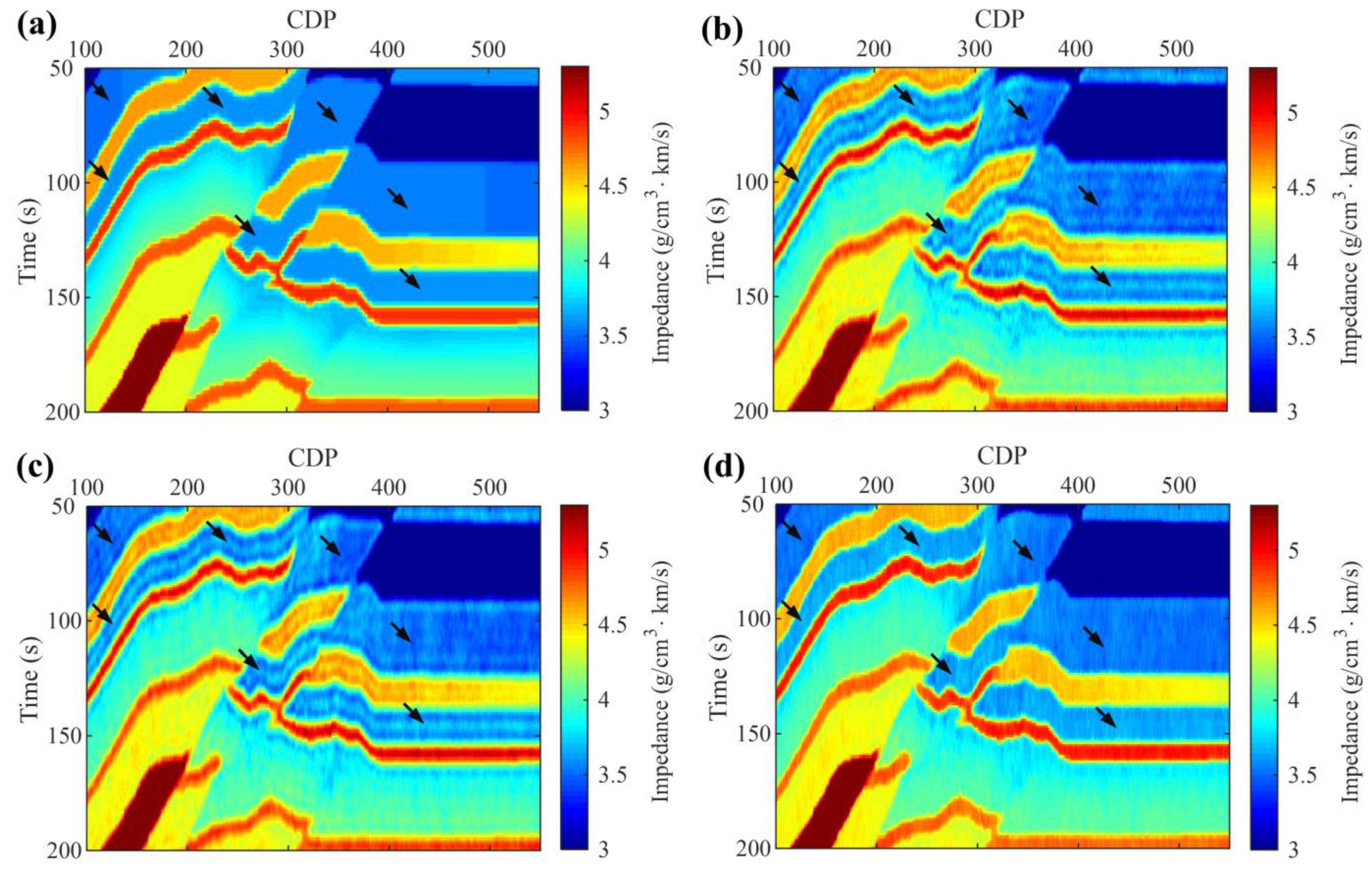
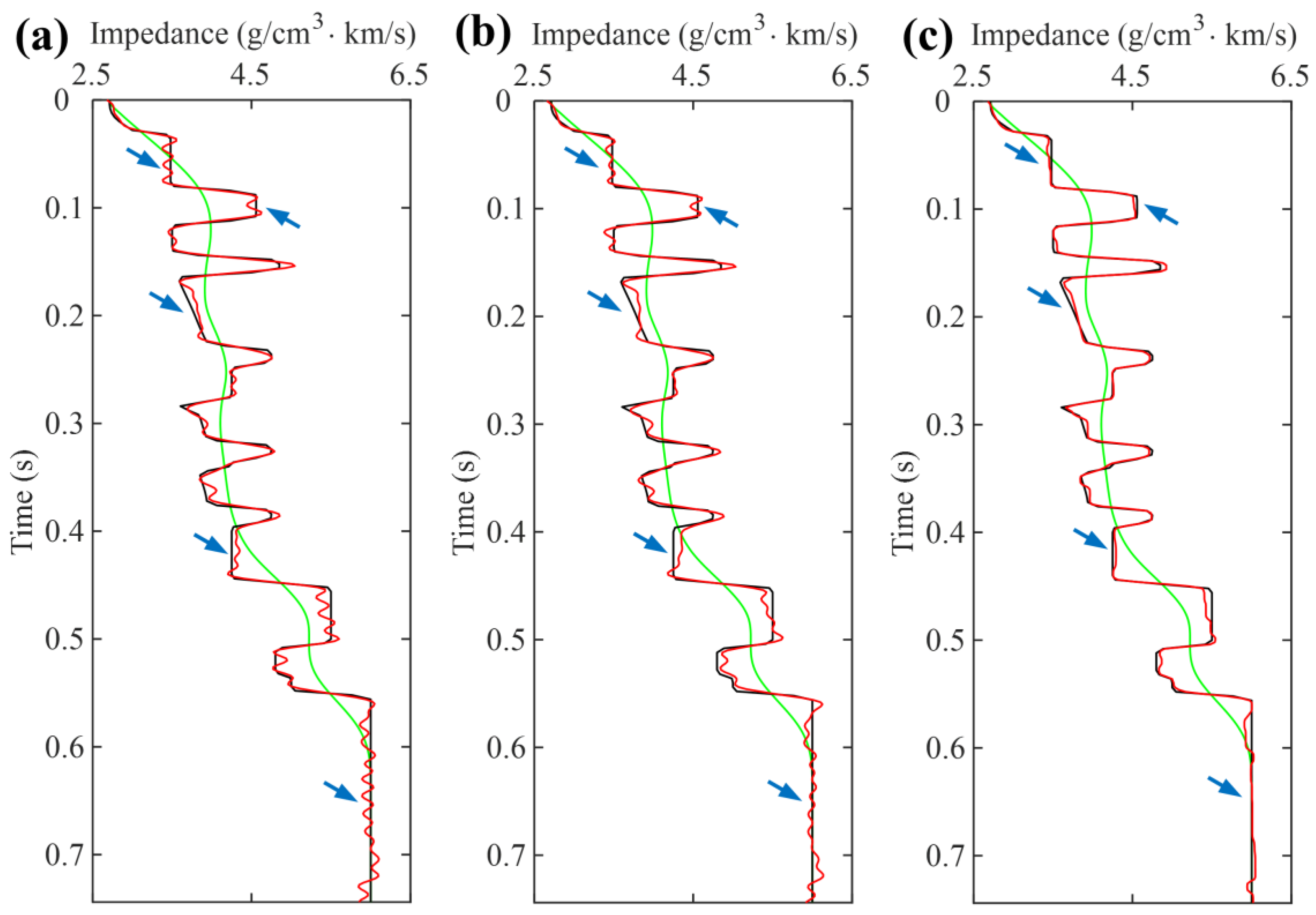

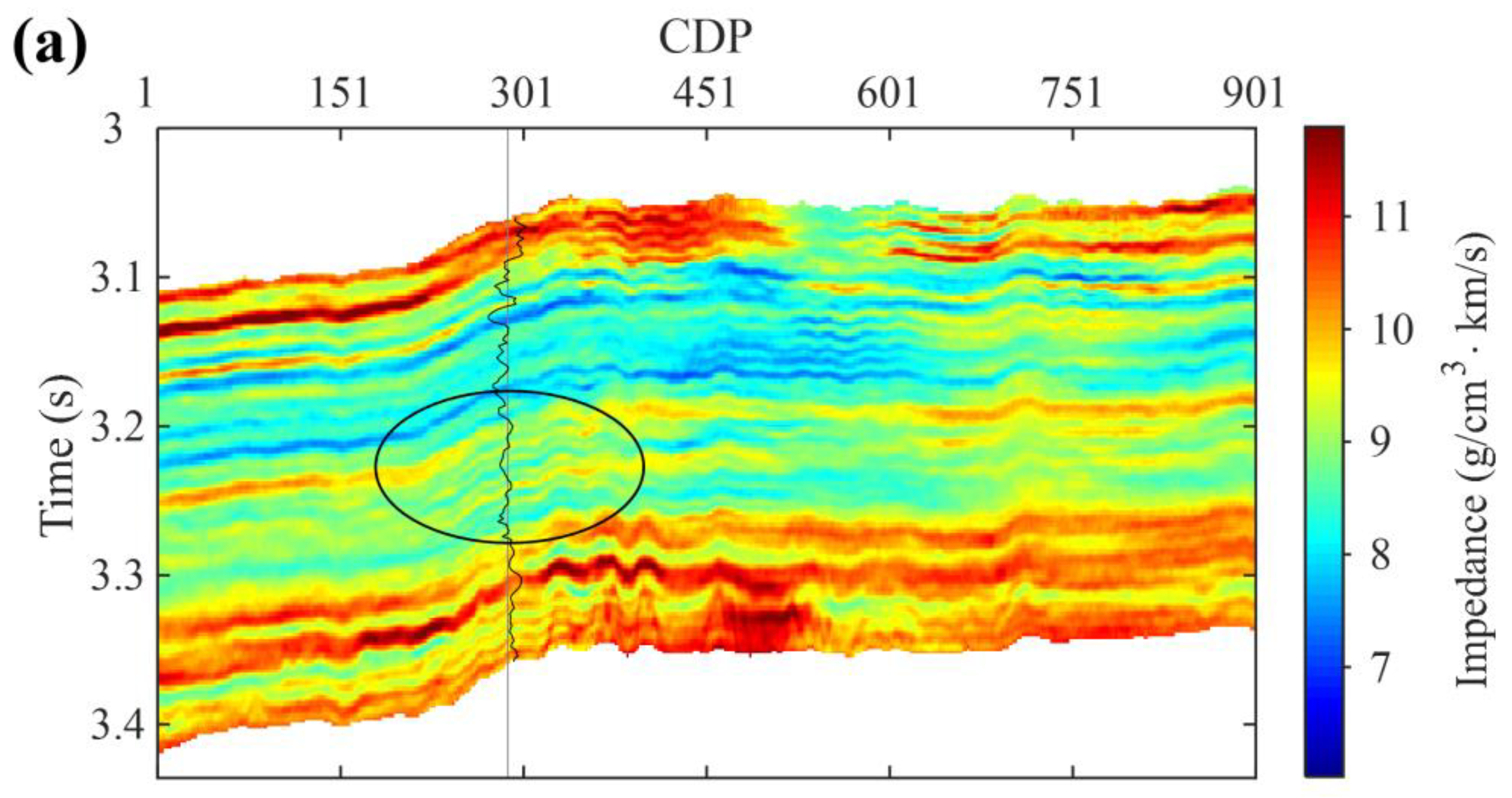

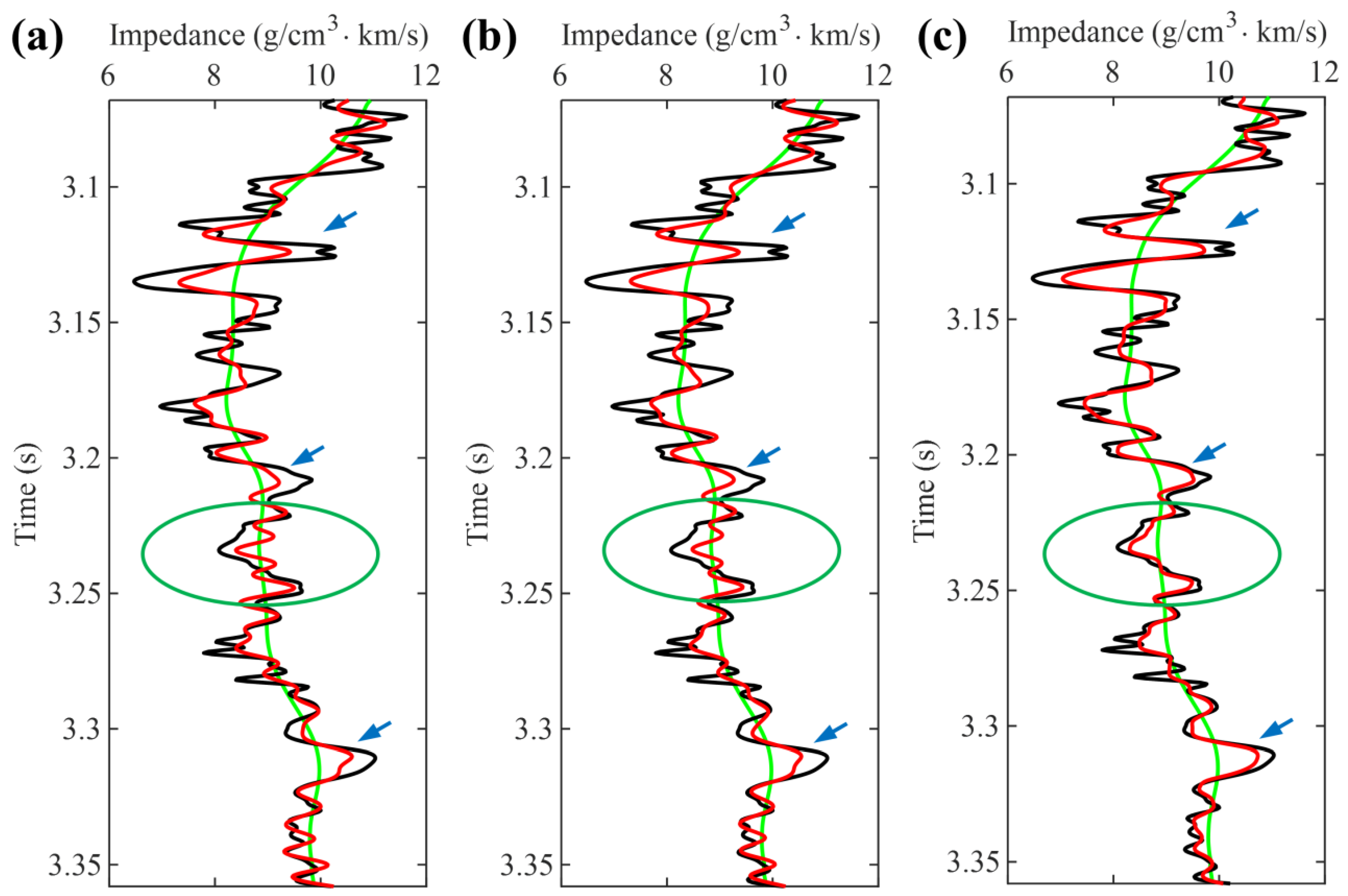

| Method | RMSE (×10−3) | Time (s) |
|---|---|---|
| MII | 46.10 | 261.89 |
| LMII | 46.11 | 135.13 |
| Constrained LMII | 29.06 | 161.17 |
| Method | RMSE (×10−3) | Time (s) |
|---|---|---|
| MII | 79.93 | 269.31 |
| LMII | 79.94 | 138.28 |
| Constrained LMII | 57.92 | 165.80 |
Disclaimer/Publisher’s Note: The statements, opinions and data contained in all publications are solely those of the individual author(s) and contributor(s) and not of MDPI and/or the editor(s). MDPI and/or the editor(s) disclaim responsibility for any injury to people or property resulting from any ideas, methods, instructions or products referred to in the content. |
© 2023 by the authors. Licensee MDPI, Basel, Switzerland. This article is an open access article distributed under the terms and conditions of the Creative Commons Attribution (CC BY) license (https://creativecommons.org/licenses/by/4.0/).
Share and Cite
Lan, N.; Zhang, F.; Xiao, K.; Zhang, H.; Lin, Y. Low-Dimensional Multi-Trace Impedance Inversion in Sparse Space with Elastic Half Norm Constraint. Minerals 2023, 13, 972. https://doi.org/10.3390/min13070972
Lan N, Zhang F, Xiao K, Zhang H, Lin Y. Low-Dimensional Multi-Trace Impedance Inversion in Sparse Space with Elastic Half Norm Constraint. Minerals. 2023; 13(7):972. https://doi.org/10.3390/min13070972
Chicago/Turabian StyleLan, Nanying, Fanchang Zhang, Kaipan Xiao, Heng Zhang, and Yuhan Lin. 2023. "Low-Dimensional Multi-Trace Impedance Inversion in Sparse Space with Elastic Half Norm Constraint" Minerals 13, no. 7: 972. https://doi.org/10.3390/min13070972
APA StyleLan, N., Zhang, F., Xiao, K., Zhang, H., & Lin, Y. (2023). Low-Dimensional Multi-Trace Impedance Inversion in Sparse Space with Elastic Half Norm Constraint. Minerals, 13(7), 972. https://doi.org/10.3390/min13070972




